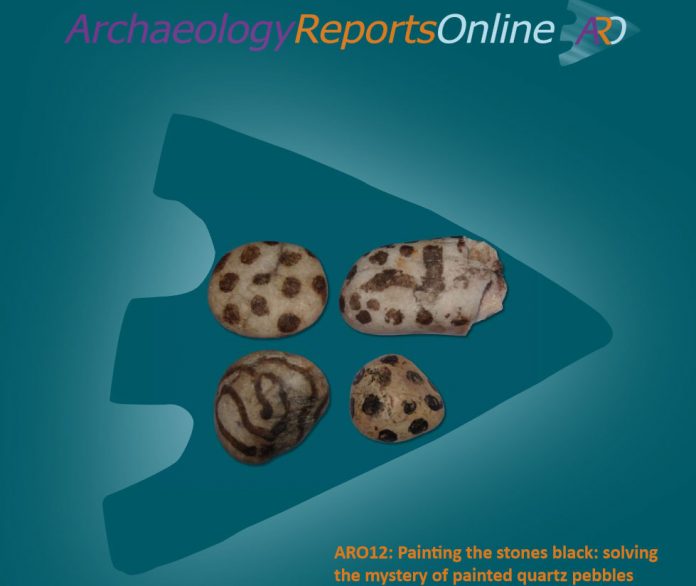The presumed emblematic value of quartz in prehistory may have been important in portable material culture; one suggestion is that the small decorated pebbles may have been used as charm-stones. Painted pebbles may have been one element of a Pictish shaman’s equipment, attributed with ancient magic powers. Others have proposed they were used as sling-shots; their differing markings making them instantly recognisable to their owners. Another, more recent suggestion concerning the function of painted pebbles is that they were produced and used in conjunction with metalworking. This discussion continues today as more of these enigmatic pebbles are unearthed.
Shetland
The majority of painted pebbles in Scotland have been found in Shetland where they form an important collection within the Shetland Museum. Experimental study of this collection by Robbie Arthur of Weisdale in the Shetland Isles and Jenny Murray of Shetland Museum and Archives was carried out to understand their decoration, the material used in painting the pebbles, the methods of application of the design and consideration of its survival.
Robbie Arthur, a stonemason by trade, observed that external gable walls containing the unlined, stone-built flues for open hearths often show a dark, blackish-brown stain, very similar to the colour of the spots on the painted pebbles. The staining penetrates right through the stonework. The distillation of vapour, from the burning of peat, occurs when the flue cools. This produces a sticky deposit which is a natural bituminous substance very like coal tar. When a fire warms the chimney again, this tar dries to a dark and shiny substance resembling pitch. It was this substance which was used for Robbie and Jenny’s experiments.
In an attempt to replicate the original designs, various methods of application were tried. In this experiment it was decided to use natural resources to recreate the motifs. At first, a straw was used, and this replicated dots, S-scrolls and lines similar to those on the Scalloway pebbles used as examples. As more dots were applied to the stone’s surface, and as the paint on the straw lessened, the dots became fainter, which was reminiscent of some of the original designs.
Reproducing the marks
To reproduce the perfect circles seen on the Buckquoy pebble, two ‘tools’ were used: the shaft of a large seagull feather cut in half, and the hollow stalk of Wild Angelica, both of which were used with good precision to duplicate the original designs. The rings produced on the experimental pebble, using the bird’s feather, were almost identical to the markings on the Balta example. The pebbles were left to dry overnight before the stability of the pigment was tested by scrubbing the stone with a coarse pot-scourer in hot water. The marks on the pebbles remained exactly the same and did not fade with further scouring. The stones were also rubbed together with no effect on the new painted symbols.
These experiments using distilled peat tar reveal a substance, which was readily available as a resource and much easier to find than haematite. In most areas where painted pebbles have been found, peat was generally used for domestic fires and also for smelting and smithing, due to the dearth of wood resources. This was especially the case in Shetland from the early Iron Age onwards. The process of peat burning produced considerable quantities of pitch, which could have also been used to water-proof ropes and fabric coverings. With no chimneys from which to retrieve the distilled tar during the Iron Age (as used in Robbie and Jenny’s experiments), peat tar was probably produced by cooling back stones around an open hearth.
Whatever their function, painted pebbles were probably significant in some way or form as a portable entity, perhaps highly valued by the people who carried them. Their numbers in the archaeological record appears to have been limited perhaps suggesting they were of revered significance, held by a certain few within communities. A new catalogue of painted pebbles records the location of these finds throughout Scotland, with single examples from as far south as Dumfries and Galloway and west to the Outer Hebrides. It also highlights predominant clusters of finds within the northeast regions of the Highlands and Islands. Why they appear more frequently in Caithness and the Northern Isles remains a mystery to be resolved, and while their purpose remains enigmatic recent excavation has offered us new information about when they were in use. Excavations at Old Scatness and Sandwick, Unst present us with reliable dates obtained from secure archaeological contexts, establishing their use from the middle Iron Age, through the late Iron Age and into the Pictish period. As more archaeological sites are investigated in the future we may yet find further clues about the origin and purpose of these intriguing artefacts. The decorative motifs may have specific meaning and further research is needed into their type and distribution across the surfaces of these mysterious stones.
The full results of this research, ARO12: Painting the stones black: solving the mystery of painted quartz pebbles, which includes a new updated catalogue of all recorded painted pebbles in Scotland by Anna Ritchie, has just been published and is now freely available to download from the ARO website – www.archaeologyreportsonline.com.





